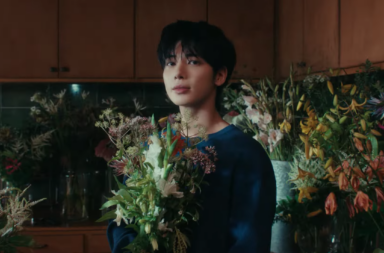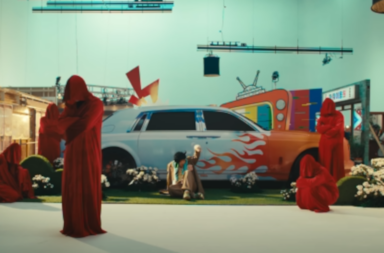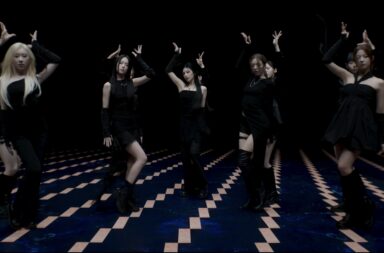In 2019, still newly-minted rookies Oneus came back with “Lit,” a bold track of celebration that features traditional Korean elements and instruments. Two years later, the six-member group has returned with “Luna.”
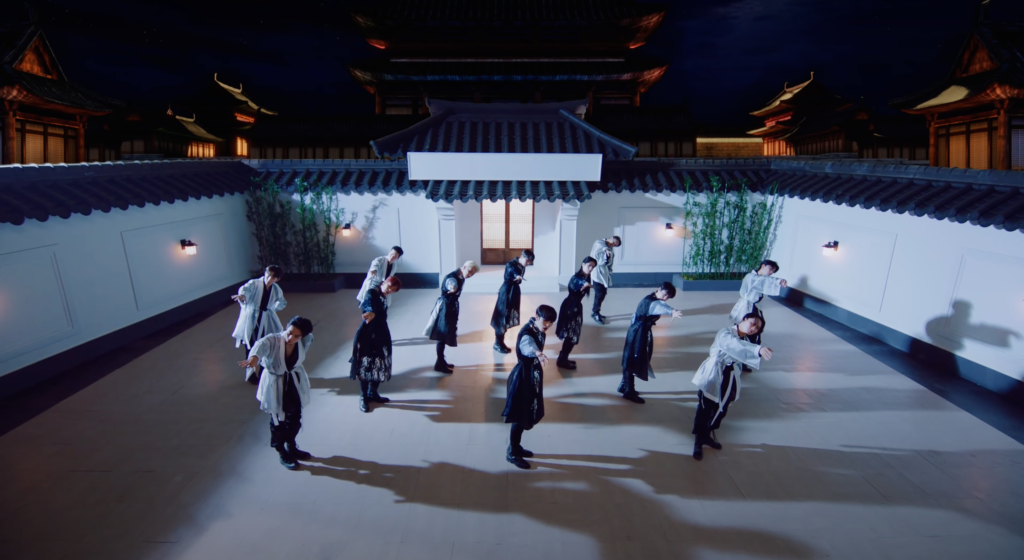
A sonic shift from Oneus’ previous release, the funky “Black Mirror,” “Luna” heralds the revival of their traditional concept. And it has been a successful turn to their cultural roots: Within a week, the MV has acquired over 18 million views. In comparison, their “Lit” MV possesses 19 million views overall, and the group’s last comeback, “Black Mirror,” has 23 million views since the MV was released six months ago.
As one can infer from the title, the “Luna” MV focuses its story and aesthetics around the moon. Light is also central to Oneus’ origins, and this element is tightly woven into the MV’s tragic romance narrative. The group captures the mythical quality of the moon as a symbol of a lost lover and the distance that is now between them, suggesting that the brightness of the moon no longer illuminates an intense love but rather reveals the darkness found on earth.
Oneus’ grief and longing is wrapped in elegance, almost to a mythical degree, as noted best in their individual sets. These solo shots—from their clothing to the lighting to the props inside of the scenes—paint a story of a regretful and heartbroken Oneus. Their futile attempts to recapture their love that they let slip by them are literally highlighted through the moonlight that no longer exists for them.
“Luna” opens with a dramatic shot of Leedo standing on a rooftop, the full moon shining behind him. Pagodas and other buildings are visible in the background, although the moon casts deep shadows on their curves and edges. Traditional instruments, such as a gayageum, a flute-like instrument, and the wavering of a haegeum, weave an ethereal sound to accompany the beginning of this MV, building a musical blend of the traditional and the contemporary.
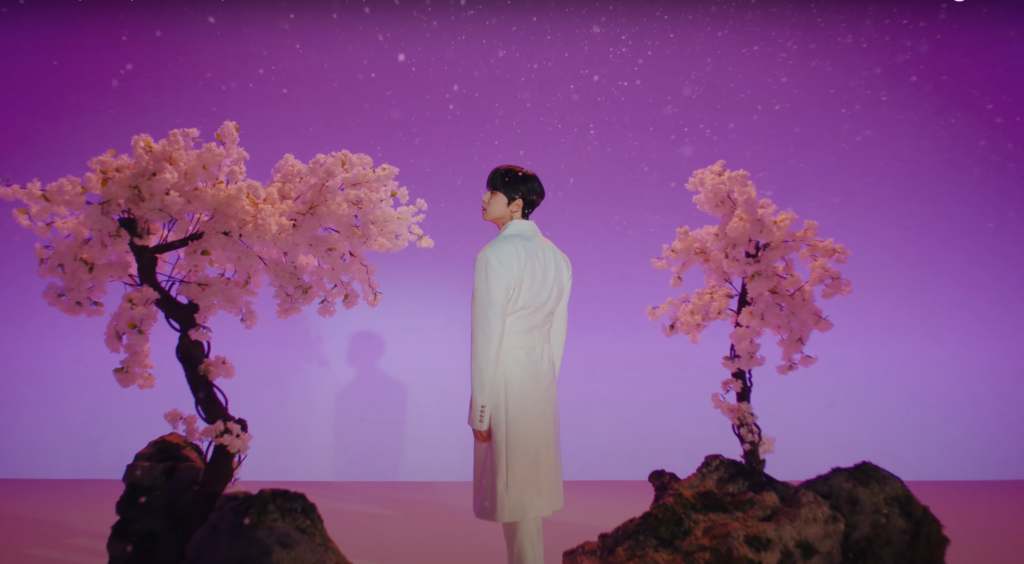
This is one of the only moments where the moon itself is present. Another are the desert scenes, such as during the bridge when Hwanwoong walks dejectedly, his head down and his hands behind his back. The rest of the MV, namely the members’ solo sets, attempt to recreate the moon, its light, and their love—now gone.
Keonhee’s scenes are some of the most upfront about this comparison. In the vein of VIXX’s “Shangri-la,” poignant simplicity rules these moments. He stands in the center of the frame at a three-quarters perspective, two cherry blossom trees flanking him. Meanwhile, flower petals fall gently around his side profile. A light shines on the vocalist, which bathes his white coat and filters behind him. Keonhee closes himself off to the camera, but his shadow in the background hints that the darkness still lurks within his view, reminding him of the pain of loss.
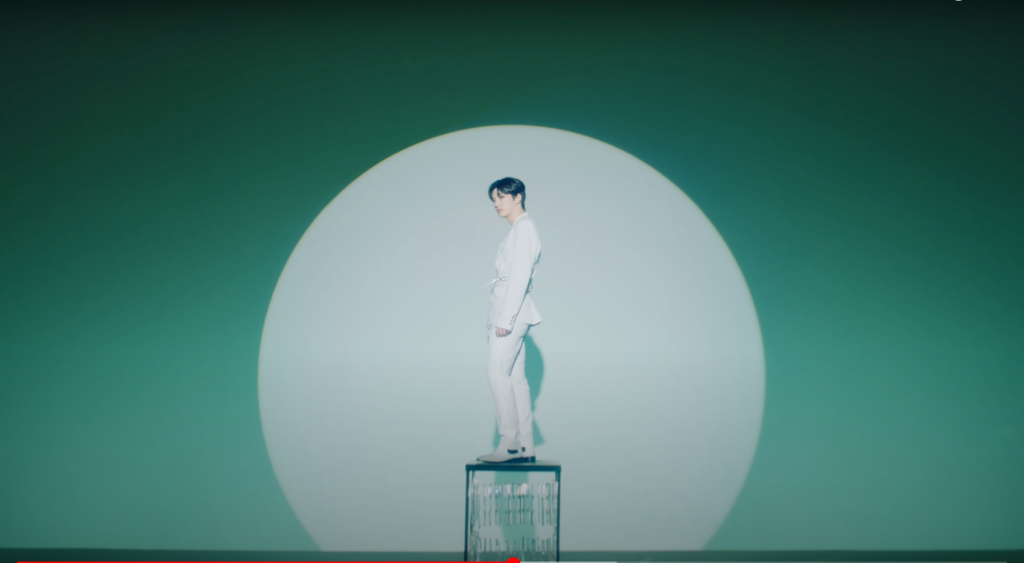
The imitation is even clearer in Seoho’s spotlight and diamond sets. While Keonhee’s shot had a softer and more romantic feeling with pinks and purples coloring the scene, Seoho’s are colder and have sharper edges. Not only are the shots dominated by greenish blue colors, but the harsh spotlight heightens the chilliness of the space. The main vocalist’s white suit is even brighter under this light, and his eyes barely meet the viewers’ under a half-lidded gaze.
In these scenes, the softness of flowers and their fallen petals is forgone. The focus, instead, is replicating the moon’s brightness and its symbolic value in the relationship that could have been. Fractured light bounces off of the tangle of diamonds Seoho hides behind, while the shape of the spotlight mimics that of the moon. Similar to Keonhee’s moment, Seoho’s shadow fits neatly in the center of the light as he sings, “Will I blossom and wither following that light?”
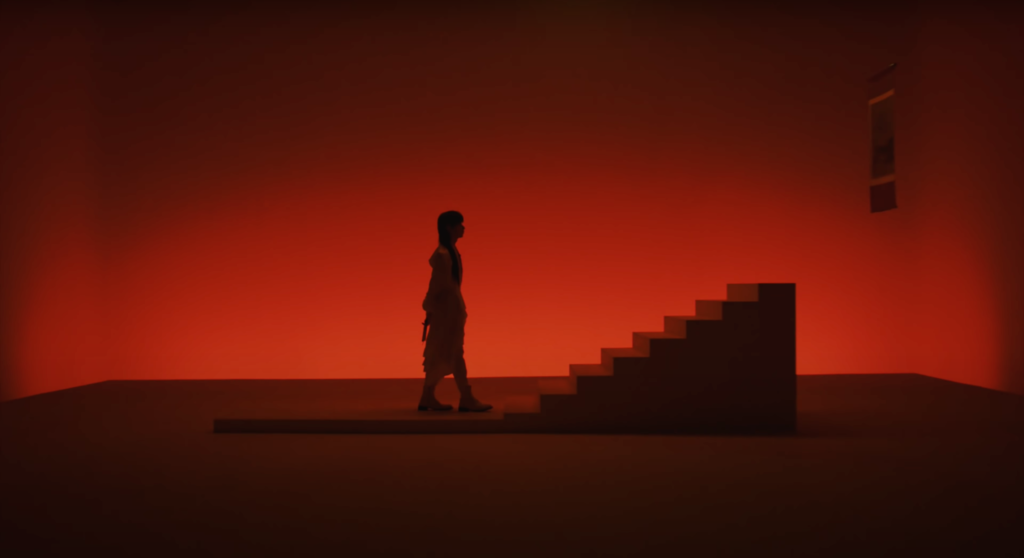
The abstract becomes a touch more tangible in Xion and Leedo’s sets through the noticeable landscape paintings in their scenes. In addition, their solo shots complement each other, forming another bridge for Oneus to connect their Korean culture to the contemporary world.
Xion is a pillar of the traditional. He wears white clothing, as Keonhee and Seoho do, but he is donned in a robe versus pants and jacket. The flowing material sways gently around Xion’s legs as he climbs the small staircase towards the right half of the mostly empty space. Colored by a gradient of orange lighting, one may not fully take in the artwork that is his destination in the first watch. The stairs abruptly end, and Xion is faced with a landscape painting of the moon and mountains, displayed on a hanging scroll suspended from nothing.
This shot is, to put it lightly, stunning. It captures the bitterness of the story as well as its mythological hints. Just like the moon can never touch the earth, Xion is unable to close the distance between himself and the painted moon. Amidst this visual elegance steeped in emotion, he sings, “That is the reason that I long for you, again / Waiting without knowing when you will return.”
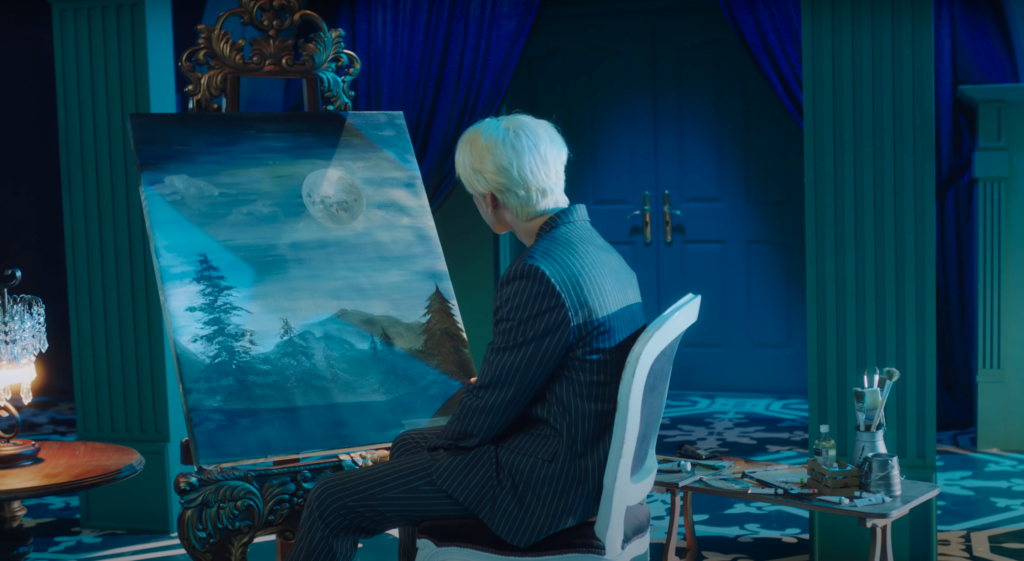
The same yearning is prevalent in Leedo’s set where he sits in front of a painted scene, similar to that which Xion had found himself face-to-face with. Leedo’s painting, however, comes from a western art tradition—oil painting—in comparison to the other work that is probably derived from Korean landscape paintings that gained popularity during the Joseon era.
Leedo’s back is turned to viewers, so the artwork is fully visible, from its tall pine trees to the moon that is clearly the object of the rapper’s attention. Light from other sources and shadows cut across the painting; yet, he is focused on the internal glow emerging from the moon. Later in the MV, there is a close-up of Leedo’s hand pressed against the painted moon. He can attempt to recreate this celestial body into something tangible, but it will never be the same.
The two are one indication that the group’s yearning for their lost love spans across time and space. No matter the time period nor the place, there is no way to change the past, and all they can do is remember.
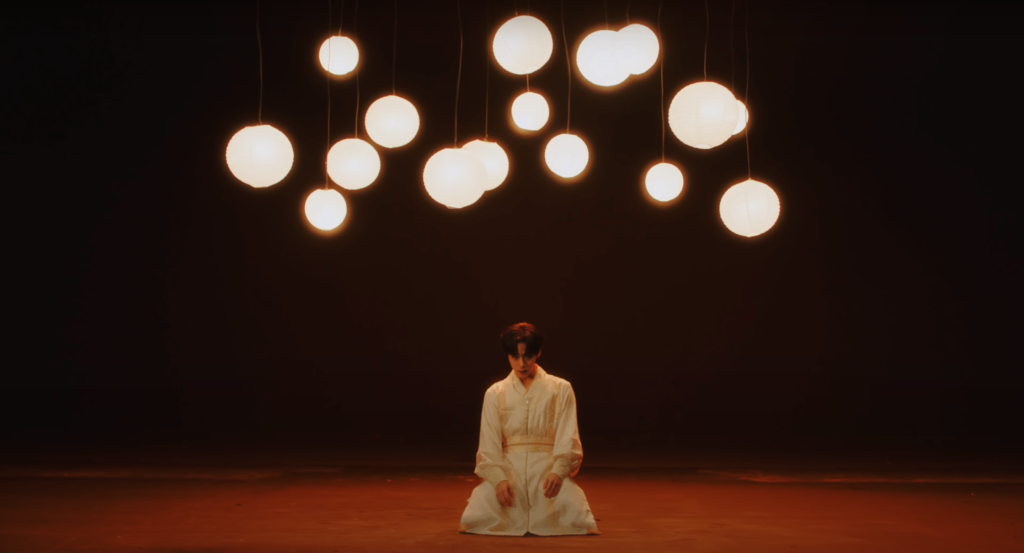
In juxtaposition to the “natural” light and landscapes found with Xion and Leedo, the artificial, particularly man-made light, is central to Hwanwoong and Ravn’s sets. Unlike the spotlights on Seoho and Keonhee, the remaining Oneus members are surrounded by more abstract imitations of moonlight.
Hwanwoong, for example, kneels under circular lanterns hung with thin wire from the ceiling. Nothing is in the background but shadows and light cast in an orange-ish shade as a result of the sand on the ground. Light may be shining on him, but the dancer rarely looks up. These lanterns are simply attempts at imitating the moon and finding a way to close the distance between lovers that could have been and hopefully easing the pain of that loss.
Artificial light also dominates Ravn’s scenes, which mostly take place in a lightbox set. As “Luna” shifts in sound to more drum and sparser instrumental support, the MV also adjusts its aesthetic. It is less on-the-nose than the first backgrounds introduced; instead, translucent screens on three out of four sides bathe the leader in blocks of color. Switching from white to blue to red, Ravn becomes more silhouette than human being with each cut. This light simultaneously illuminates and conceals.
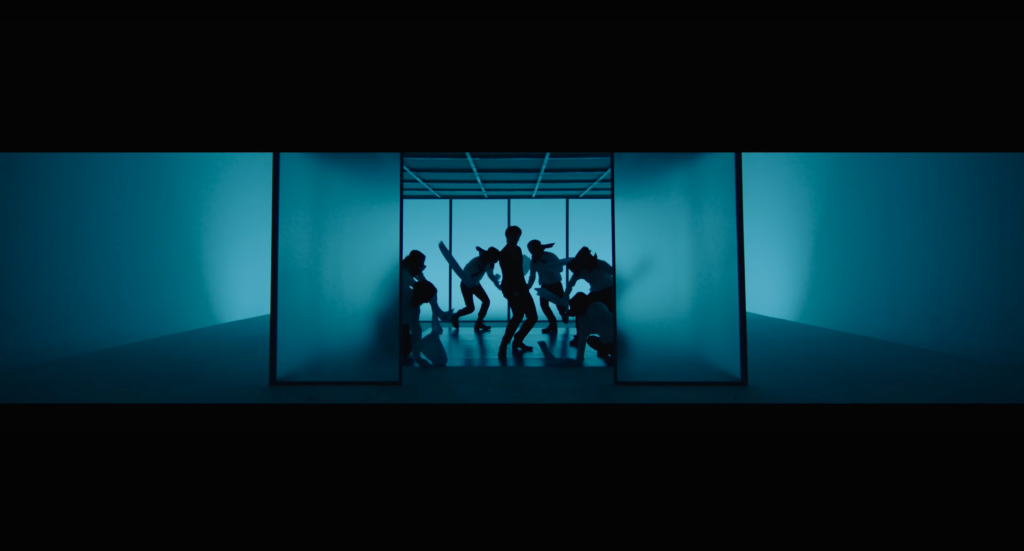
“Luna” is a layered piece of art, both in reference to the actual song and the MV. The latter seamlessly aligns its aesthetics with the emotion wrought in the lyrics (“Please tell my lover the words that I failed to deliver”) and the traditional Korean musical elements found in the track. Overflowing with images of the moon, flowers, and birds to capture a story of longing, regret, realization, and love, “Luna” weaves together tragedy and elegance. In doing so, Oneus continues to carve a definitive space for themselves within the K-pop sphere. The alluring concept and MV for “Luna” is just another reason why the group are ones to watch as they grow as artists.
(YouTube. National Gugak Center. Harvard University. Images via RBW Entertainment.)
